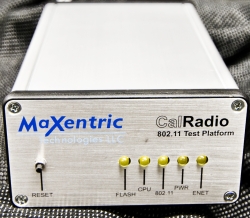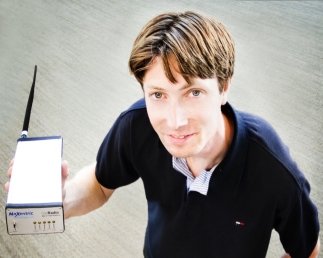Seed, Then License: A New Model for Tech Transfer at UC San Diego
|
San Diego, CA, Nov. 24, 2008 — In a departure from the standard model for commercializing academic inventions, researchers at the University of California, San Diego seeded the market first by building and distributing a new wireless device from their own labs before licensing the technology to an outside company.
MaXentric Technologies LLC is now shipping the device under a licensing agreement with UC San Diego. The company is producing, marketing and distributing CalRadio I, a wireless Wi-Fi testing and development platform first created by engineers in the UCSD division of the California Institute for Telecommunications and Information Technology (Calit2).
Before signing the deal with MaXentric, Calit2 transferred approximately 50 CalRadio devices directly to corporate, federal and academic organizations via UCSD's material transfer program - with all of the devices built from scratch at Calit2. By contrast, most campus inventions never reach the market unless they are licensed first (either by a startup company or an existing manufacturer). (A link to more information on UCSD's material transfer program can be found below.)
|
"The unique aspect of this is that it has grown from research samples being shipped direct from campus under material transfer agreements," notes Dave Gibbons, assistant director for physical sciences licensing in the UC San Diego Technology Transfer Office. "By first seeding and proving the market, Calit2 was able to build great value into CalRadio as a licensing play. Value that might not have otherwise been realized."
MaXentric initiated a campaign to market CalRadio I last month, with their presence at the NAVAIR Small Business Aviation Technology Conference.
CalRadio is a wireless transceiver research program at Calit2 on the UC San Diego campus. The program develops broad application radio-frequency (RF) and networking research and development test platforms.
"CalRadio simplifies the task of obtaining real-world performance analysis for RF and networking research across device layers," says Doug Palmer, a principal development engineer who led the effort to develop CalRadio at Calit2.
|
CalRadio I is the first generation of the testing platform. It is a low-cost software-defined, radio-based test platform for 802.11b MAC layer (layer 2) research and development. It functions as a test instrument, an access point, and as a Wi-Fi client.
"At a relatively inexpensive cost, CalRadio allows researchers to implement their algorithms on actual hardware, versus software simulations," explains Houman Ghajari of MaXentric. "It gives researchers the capability of programming with tools that programmers who are working in this field are accustomed to using." Ghajari is MaXentric's director of government systems and technology.
MaXentric's headquarters are in New Jersey; they also have a satellite office in San Diego. Ghajari, who received his Master's degree in electrical and computer engineering from UC San Diego's Jacobs School of Engineering, has been working on collaborative projects with Palmer, fellow principal development engineer Don Kimball, and other researchers at Calit2, as well as other UC San Diego researchers. They currently have four research and development collaborations on campus - two of them at Calit2, including CalRadio.
"Working with Calit2, we have access to the best researchers in the country," says Ghajari. "Calit2 people tend to be on the practical end of the research. When we go after a problem, we're both looking at the practical aspect of it. We don't need to make the connection from the basic theoretical point of view into the real-world need. With Calit2 researchers, those gaps disappear."
|
CalRadio research continues at Calit2 on the next generation, CalRadio II, which MaXentric intends to license when it is ready and available. In addition, there is a thriving user community working independently on improving the open source framework of CalRadio I, which includes several Calit2 and Jacobs School engineers and researchers, as well as MaXentric engineers. The working group is international, including members from Padova, Italy and a university in Shanghai, China. Calit2 postdoctoral researcher Anders Nilsson Plymoth, from Sweden, is a key researcher in this effort.
"My main objective working with CalRadio has been to develop and test some schemes for opportunistic forwarding in wireless networking," explains Nilsson Plymoth, who has been testing and improving the CalRadio I software and making it more compatible with standard 802.11 devices, while working on developing the MAC protocol for opportunistic forwarding. Nilsson Plymoth has been working closely with Mikhail Afanasyev, a fourth-year doctoral student in computer science and engineering at UC San Diego, as well as other members of the user community.
CalRadio platforms are for broad access by the wireless community for research and development. A single integrated test platform gives a new dimension to radio design in the future: the capability of publishing standards in software/firmware and hardware. This has the utility of greatly speeding the design, implementation and adoption of new standards.
"Every university wireless lab will likely host CalRadios in a few years time," states UC San Diego tech-transfer expert Gibbons. "They will enable education of new engineers with the latest in flexible design platforms for wireless communications."
About Calit2 at UC San Diego
The UC San Diego Division of the California Institute for Telecommunications and Information Technology (Calit2), together with Calit2's division at UC Irvine, house over 1,000 researchers across the two campuses, organized around more than 50 projects. With a focus on discovery and innovation at the intersection of science, engineering and the arts, Calit2 constitutes one of the largest multidisciplinary research centers in the nation.
Created in 2000 by the State of California to maintain and extend its leadership in critical technologies, Calit2 brings together teams of faculty, student and staff researchers on both campuses with leading California telecommunications, computer, software, and applications companies. Research is conducted in areas such as environmental science, civil infrastructure, intelligent transportation and telematics, genomics, telemedicine, new media arts and digital cinema. www.calit2.net
About MaXentric
MaXentric Technologies LLC is an advanced technology research, development and consulting company servicing commercial and government markets. MaXentric has extensive experience in various new technology developments and network deployments including digital cellular, PCS, satellite radio, terrestrial and satellite multimedia broadcast (MediaFlo, DVB-T/H/S, S-TiMi, MVDDS), RFID, military communications, and sensor networks.
MaXentric offers an array of technology development and deployment services as well as a suite of products test equipment for development and manufacturing. In government services, MaXentric provides innovative technical and operational solutions for the technical challenges facing DoD and other governmental agencies. Activities are concentrated on Communication Networks, Sensor Networks and Data Fusion and Advanced Information Theory. www.maxentric.com
Related Links
MaXentric CalRadio website
Calit2 CalRadio website
UCSD Material Transfer Program
Media Contacts
Maureen C. Curran, mcurran@soe.ucsd.edu, 858.822.4084.




